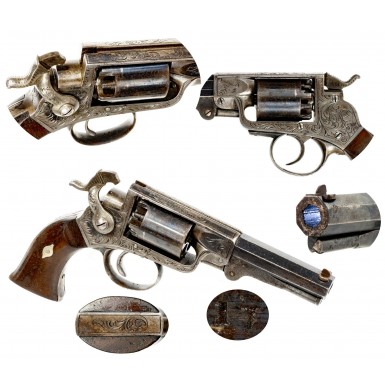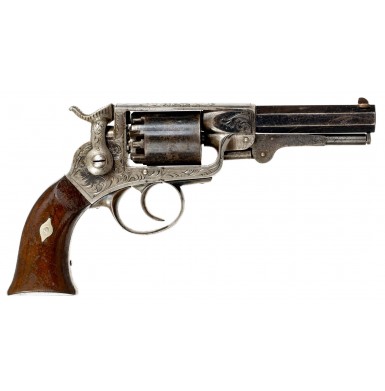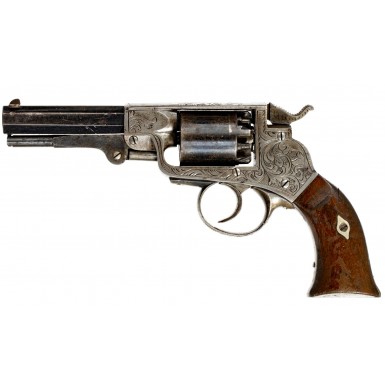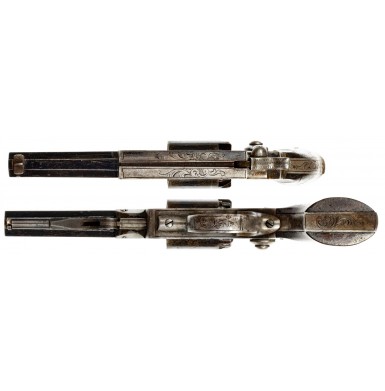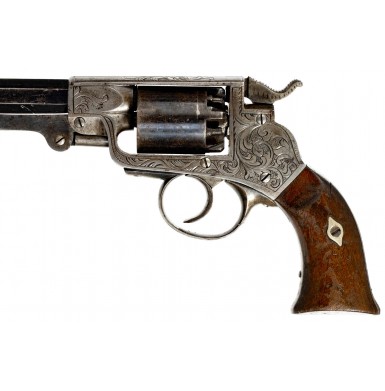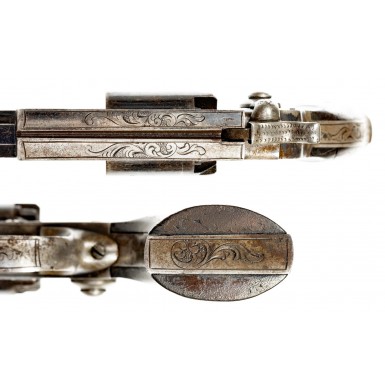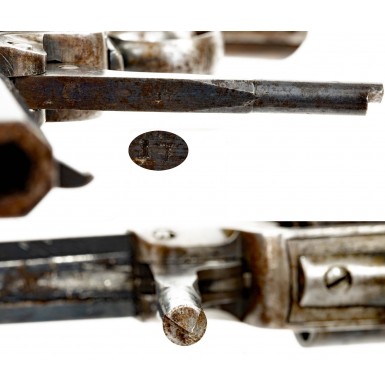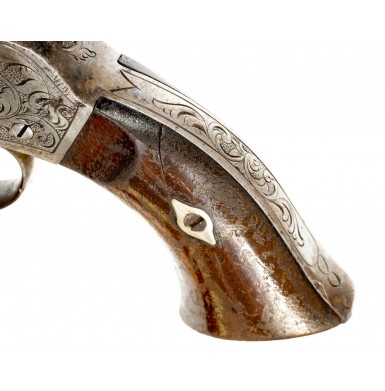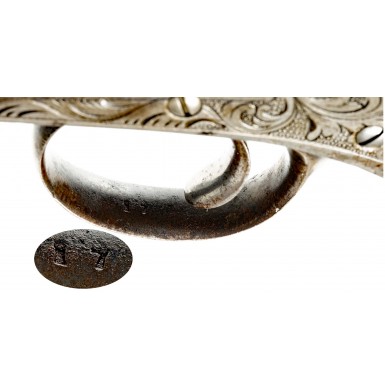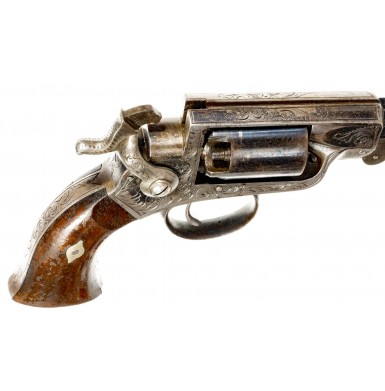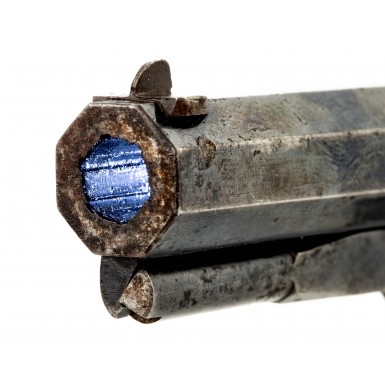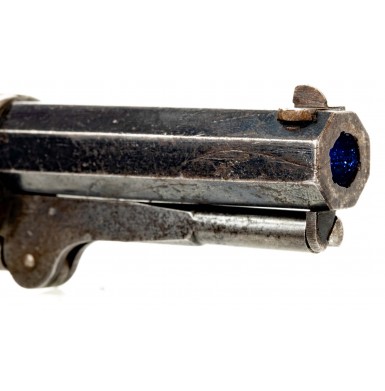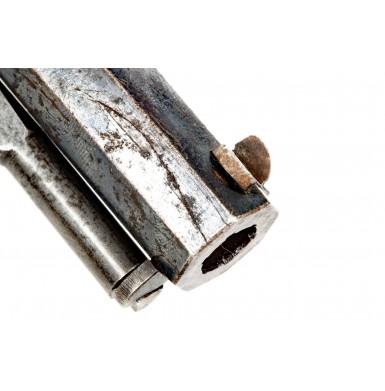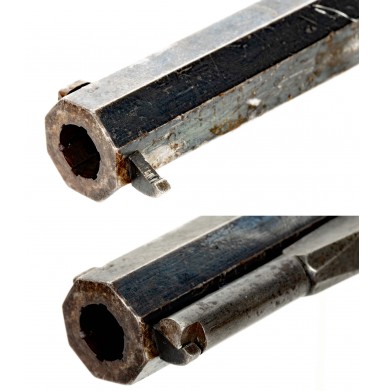Extremely Rare IXL Navy Percussion Revolver
- Product Code: FHG-2280-SOLD
- Availability: Out Of Stock
-
$1.00
For a brief period circa 1857 a series of double action percussion revolvers were produced that are known to collectors as the IXL Percussion Revolvers. To date, the actual manufacturer of these guns is unknow, but some evidence points to IXL being a trade name of Benjamin J. Hart, a New York City based gun and sporting goods retailer who operated circa 1848-1865. At least a few of the Pocket Model IXL Revolvers are known with the B.J. HART / BROADWAY retailer marking, so Hart was at the very least a seller of the guns and may have actually contracted for their manufacture, along the lines of modern day OEM manufacturing. Like most percussion revolvers of the mid-19th century, the guns were produced in two basic frame sizes; a .31 caliber “pocket” size and a .36 caliber “navy” size. Both versions were produced in two design variants. All models were five-shot, double action revolvers with Colt-style under-barrel loading levers. The lever catch was a uniquely machined piece that engaged mirror image machining on the face of the lever. This was a simple and artistic way to lock the lever in place without relying upon any kind of spring loaded catch or mechanism; the catch was based entirely upon geometry and friction. It appears that blued finishes with color casehardened hammers and loading levers were standard. Most known examples have frames engraved with New York style foliate arabesque scrolls and the two-piece smooth walnut grips were varnished. One of the more interesting features of the larger, “navy” sized revolver was a removable circular sideplate on the left side of the frame that allowed access to the revolver’s mechanism.
The smaller, IXL Pocket Model was nominally .31 caliber with 4” octagonal barrels being standard. The most common variant was a double-action-only revolver with a center-mounted spurless hammer. It is believed that about seven hundred and fifty of these revolvers were produced. These guns are marked IXL N. YORK on the top barrel flat, which is how the series of guns had been identified as IXL revolvers. Some of these guns are also found with the B.J. Hart retailer marking. The IXL marking is likely a reference to the trademark of Sheffield knife maker George Wostenholm who produced bowie knives marked I*XL, which literally means “I excel.” A second, much rarer version of the pocket revolver was produced with a side-mounted spurred hammer and a “conventional double action” mechanism, which meant it could be manually cocked and used like a single action revolver or the trigger could be pulled with the hammer down for double action use. According to Flayderman’s Guide to Antique American Firearms, only one hundred and fifty of these revolvers were produced and they were unmarked other than with their serial numbers.
The larger version of the IXL handgun was the IXL Navy, a nominally .36 caliber revolver with a 7” octagonal barrel being standard according to Flayderman’s. However, it appears that 5” was also a standard barrel length. Again, the guns were produced in two variations, a spurless, center-mounted hammer double action only version and a side hammer, conventional single/double action version. According to Flayderman’s neither variant is marked except for serial numbers and both versions are believed to have been produced in very small quantities with fifty being the estimated production for each one. I have a feeling that most of the guns are found unmarked due to quality control issues which rendered at least some of the IXL Navy revolvers dangerous to the user.
Other than Flayderman’s, very little is available in print about these rare revolvers and a serious scouring of the internet has revealed very little additional material about them. In particular I searched for anything about the rare, sidehammer single action/double action IXL Navy Revolver, as that is the very rare handgun that I am offering for sale here. I could only come up with sales records for and references to three examples over the past 10-15 years, and two of these guns sold twice during that time. The guns were IXL Navy Revolvers serial numbers 5, 17 and 38.
IXL Navy #5 is probably the most famous of the guns known. It was part of the famous Al Cali Collection of percussion revolvers that was sold by Sotheby’s in 2014. The gun has a 7” barrel and to date is the only example of a side hammer IXL Navy I can find that does have a 7” barrel! This gun had experienced a catastrophic failure during the period of use and the frame was blown apart at the upper rear behind the cylinder and at the lower front near the loading lever. It was brazed back together and had large rivets peened into it for additional support. The repair apparently resulted in the frame being re-machined removing all of the typical frame engraving. The large circular access panel on the left side of the frame to be able to access and work on the mechanism appears to be a replacement on #5, as are the screws that secure it. Despite all of the repair work, in 2014 the revolver sold at Sotheby’s for $9,375.00 including the buyer’s premium. IXL Navy #5 was sold again in May of 2020 by Cowan’s Auctions and this time realized roughly half that amount, selling for $4,800 including the buyer’s premium. Considering the extensive repairs and lack of finish, this seems like a more reasonable price point. Despite the serious damage and repairs, it is a very rare gun.
IXL Navy #38 was sold by Rock Island Auctions in December of 2009. That revolver had a 5” barrel that appears to be completely correct and factory. I am of the opinion that both 5” and 7” barrels were standard for these scarce revolvers. Gun #38 was not engraved and was poorly refinished with a spurious “C S” mark added to the lower front of the frame. It still sold for $3,163 including the buyer’s premium at that time. Based solely on inflation, that is equivalent to $3,860 today.
Finally, there is the gun that I am offering, IXL Navy Revolver serial number 17. This gun was sold by James D. Julia in their Fall 2011 auction. At that time the gun was in an incorrect English casing with incorrect accoutrements. The gun was cataloged by the late J.R. LaRue, one of the great luminaries of the antique firearms business in his day. Mr. LaRue listed the gun has having 4 ½” is barrel, which is not quite correct, as the more accurate measurement is 4 3/8”. Mr. LaRue hypothesized that the gun was in a newly discovered barrel length, referencing Flayderman’s listing of the barrels being 7” in length. He noted that the case would accommodate a gun with a barrel of that length, but as noted the casing is clearly not correct for or original to the gun. A close examination of the revolver reveals that like IXL Navy #5, IXL Navy #17 appears to have suffered a catastrophic failure. In this case the failure was in the barrel. It is my belief that this was originally a factory 5” barreled gun and during the period of use the barrel was damaged, likely due to a flaw in the barrel iron. Close inspection reveals a wavy flaw in the metal of the right barrel flat, running from the muzzle for about 1” towards the frame. This flaw is a “grain crack” in the iron and can be seen on the interior of the barrel in the bore as well. I believe that the barrel may have failed either because of this flaw or because a blockage created the flaw. The barrel was subsequently cut back from 5” to 4 3/8” in length during the period of use to make the revolver useable again. As part of the repair, the front sight was reset, and the loading lever shortened with the loading lever catch reset as well. The work is wonderfully done and certainly has the age, patina and appearance of period work. In fact, I believe the gun was put back into service during the period, which is why the bore shows some scattered oxidation from use, there is wear to the blue from carry and use and there is some light to moderate oxidation in the recesses at the rear of the cylinder. At the Julia’s auction, the gun and the incorrect casing was sold for $11,500, including the buyer’s premium. It was then offered for sale on a major internet antique arms retailer’s sight for $16,500. I recently obtained this gun and I am able to offer it for a much more reasonable price and without the incorrect casing that it was in for the last several decades. Based upon my search of known examples offered for sale, this example retains the most original finish and other than the period shortening of the barrel remains about as nice and crisp an example as can be found. There are certainly no other IXL Navy Revolvers, particularly the side hammer examples, for sale on the market.
As noted, the pistol now has a 4 3/8” octagonal barrel and measures approximately 8 7/8” in overall length. The gun is unmarked except for the serial number 17, which is found on the left side of the frame (under the grip), on the face of the cylinder, on the top of the loading lever, inside the triggerguard and in both of the grips in pencil. The frame is engraved in a New York style with flowing foliate scrolls with a punch-dot background and lined shading. The hammer neck is engraved en-suite, as is the triggerguard, backstrap and butt. The gun remains in about FINE condition with roughly 40%-50% of the original bright blue remaining on the gun overall. The barrel retains the largest amount of blue, with about 70%+ bright blue coverage with scattered surface oxidation, and loss due to fading, thinning and wear. The cylinder retains about 50%+ of its blue, with most of the loss due to fading, thinning and use with a noticeable “turn line” from the bolt stop and the most obvious loss at the front edge of the cylinder. The frame retains about 10% of its blue, with most of the surviving finish around the barrel web section of the frame forward of the cylinder and in protected areas. The triggerguard, backstrap and gripstrap only retain minor traces of finish. The loading lever retains some muted traces of mottled case colors. The areas of exposed metal where the blue has worn or faded have developed a mostly dull pewter patina with scattered surface oxidation and some small areas of minor surface crust and minor roughness. There are flecks of surface oxidation and some surface crust scattered along the barrel, much of which could probably be carefully cleaned. The face of the cylinder shows moderate surface oxidation with some light erosion and the percussion cone recesses show moderate oxidation as well, with some pinprick pitting. The cones (nipples) themselves are in fine, crisp condition and show only some light use and impact marks. As noted, it is my opinion that the gun suffered a catastrophic barrel failure during the period of use. This resulted in the barrel being shortened, probably from an original 5” to the current 4 3/8”. What appears to be the original blade front sight has been installed in a barrel dovetail. This exact same pattern of sight is present on gun #38. The loading lever was appropriately shortened with the end re-machined to correctly engage the relocated lever catch. A nominally 1” long curving flaw in the barrel iron is clearly visible running from the muzzle back towards the cylinder and the same flaw can be seen inside the barrel under magnification with good light. The six-groove bore rates about VERY GOOD+ with strong rifling and scattered patches of both bright metal and oxidized darkness. The bore shows scattered surface oxidation and some small areas of surface rust, along with scattered light pitting along its length with some small areas of more significant pitting. A good scrubbing would likely improve the bore significantly. The revolver remains mechanically excellent and functions exactly as it should in both single and double action modes. The revolver times, indexes and locks up exactly as it should. The grips are in about NEAR FINE condition as well. They retain about 30%+ of their original varnish and remain mostly crisp and sharp with scattered bumps, dings and handling marks. The grips are solid and complete and free of any breaks or repairs. There is a grain crack running from the upper edge of the left grip to the German silver grip screw escutcheon. The crack is less than 1” in length and is slightly open near the backstrap. The crack does appear to be solid and stable.
Overall this is an extremely attractive and extremely displayable example of one of the great rarities in American percussion revolver collecting. While I am quite sure that a handful of examples survive in collections that I am not aware of, there have clearly been very few of these rare guns offered for sale over the past decade. Of those guns, this is the finest condition example with lots of original finish and with lovely, crisp engraving. The gun is mechanically fine and other than the shortening of the barrel, remains in really wonderful condition. The main reason I did all of the research I did was to establish a base line for the value of this very scarce gun. As in any field, you can only value an item based upon comparable item sales. Based upon the recent sale of the heavily repaired #5 IXL Navy only a few months ago, I think I have priced this gun very aggressively and very fairly. If you collect Civil War era percussion revolvers you may never get another chance to acquire one of these extremely scarce percussion revolvers and I will be very surprised if this gun remains for sale for more than a few days. Don’t miss you chance to obtain one of the great rarities in American percussion revolver collecting at an extremely fair price.
SOLD

